- Home
- Jared Diamond
The Third Chimpanzee for Young People Page 3
The Third Chimpanzee for Young People Read online
Page 3
MAN, THE NOT-SO-GREAT HUNTER?
HOW DID OUR ANCESTORS MAKE THEIR LIVING during the million and a half years between the appearance of Homo erectus and the appearance of Homo sapiens?
The only tools from this period are crude stone artifacts. They vary in size and shape. Archaeologists have used these differences to give the tools names such as hand axe and chopper. In reality, though, these may be just guesses. Wear marks show that all sizes and shapes of tools were used to cut meat, bone, hides, wood, and plants. The tools were not finely made or specialized for particular uses, as later stone tools were.
What food did our ancestors get with these crude tools, and how did they get it? A common image in books about our origins is Man the Hunter. Some anthropologists, the scientists who study human societies, have suggested that big-game hunting was what led protohumans to cooperate with one another, develop language and big brains, join into bands, and share food.
Western writers and scientists are not the only people with an exaggerated view of hunting. In New Guinea, I lived with real hunters, men who had just recently come out of the Stone Age. At campfires, they talked for hours about hunting. You would think they ate fresh kangaroo meat every day and did little except hunt. But when pressed for details, most admitted that they had bagged only a few kangaroos in their whole lives. One morning I set out with a group of a dozen men armed with bows and arrows. As we passed a fallen tree, the men began shouting. Convinced that an enraged boar or kangaroo was about to come out fighting, I looked for a tree to climb. Then I heard triumphant shrieks, and out of the brush came two mighty hunters holding their prey: a pair of baby wrens, barely able to fly. The rest of the day’s catch consisted of a few frogs and many mushrooms.
There’s no doubt that our early ancestors ate some meat. Their tools left marks on animal bones, and cutting meat from those bones left marks on their tools. But how much big-game hunting did they do, and how much of their meat did they get by scavenging the carcasses of animals that were already dead? The oldest really good evidence of human hunting comes from about one hundred thousand years ago—and it’s clear that humans then were not yet very effective as hunters. Hundreds of thousands of years earlier, they must have been even worse at it.
Studies of modern hunter-gatherer people— who have far better weapons than early Homo sapiens had—show that most of a family’s calories come from plant foods gathered by women. Occasionally the men bag a large animal, which contributes significantly to protein intake, but only in the Arctic is big-game hunting the main food source.
I question the usual view that hunting was the driving force behind our uniquely human brain and societies. My guess is that big-game hunting made only small contributions to our diet until after we had evolved fully modern anatomy and behavior. For most of our history we were not mighty hunters but skilled chimps, using stone tools to acquire and prepare plants and small animals, bagging big animals only occasionally.
Ice Age Neanderthals
In the period just before the Great Leap Forward, at least three distinct populations of humans lived in different parts of the world. These were the last truly primitive humans, replaced by modern humans at the time of the Great Leap. The best-known of these populations lived in an area that stretched from western Europe through southern Russia and the Middle East to Central Asia. They were the Neanderthals.
The earliest fully Neanderthal skulls and bones date to around 130,000 years ago, although some older bones have features pointing toward the Neanderthals. Most Neanderthal remains come from later than 74,000 years ago. The last Neanderthals died sometime after 60,000 years ago. This means that the Neanderthals flourished when Europe and Asia were in the grip of the last Ice Age. They must have been adapted to life in the cold, but only within limits. They got no farther north than southern Britain, northern Germany, and the Caspian Sea (in Central Asia). The first people to enter Siberia and the Arctic were later, fully modern humans.
Neanderthals’ heads were shaped so differently from ours that even in a business suit or designer dress, a Neanderthal would draw stares on the streets of New York or London. Their eyebrows rested on bulging bony ridges, and their noses, jaws, and teeth stuck out farther than the upper part of their faces. Their foreheads were low and slanted, and their lower jaws sloped back without chins. Still, their brains were nearly 10 percent larger than ours! They were heavily muscled in their shoulders and necks, and the bones of their arms and legs were thicker than ours. Even their hands were much more powerful than ours. A Neanderthal’s handshake would have been literally bone-crushing.
Besides their bones, our main source of information about Neanderthals is their stone tools. Like earlier human tools, Neanderthal tools may have been simple hand-held stones, not mounted on separate parts such as handles. The tools don’t fall into distinct types with specialized functions. Some stone blades were undoubtedly used to make wooden tools, but few wooden objects have survived. One exception is an eight-foot-long thrusting spear of wood, found in Germany in the ribs of a long-extinct species of elephant. In spite of that success, though, Neanderthals were probably not very good at big-game hunting. Their numbers were few, and even anatomically modern people living in Africa at the same time as the Neanderthals were not great hunters.
Neanderthals must have built shelters against the cold climate in which they lived, but those shelters must have been crude. All that remains is a few piles of stones and some holes that once held wooden posts, compared with the elaborate remains of houses built later by the Cro-Magnons. Neanderthals must also have worn skins or furs, but they had no needles for sewing fitted garments. They also lacked boats, long-distance trade, and probably art.
Finally, the Neanderthals seem to have lacked that most important human quality, innovation, or the ability to invent new things. We know this because their tools did not vary across time or place. Tools that Neanderthals used in Europe sixty thousand years ago look just like the ones they used a hundred thousand years ago in the Middle East. Despite the Neanderthals’ big brains, something was missing.
Yet there are ways in which we can relate to the Neanderthals as human. For one thing, they are the first people to leave clear evidence that they regularly used fire. Well-preserved Neanderthal caves have small areas of ash and charcoal, signs of simple fireplaces. For another, they may also have been the first people who regularly buried their dead, although the evidence on that point is not yet completely clear.
An early scientific drawing of ancient stone tools found in southeast England. For a million years or more, such tools were the cutting edge of human technology. Although some have been given labels such as “hand axe,” scientists do not know how their makers used them. Sharp- edged blades such as these could have cut through roots and branches, or skins and animal flesh.
We do know, though, that Neanderthals took care of the sick and aged people among them. Most skeletons of older individuals show signs of serious physical weaknesses, such as withered arms, missing teeth, and poorly healed broken bones. Only care by young Neanderthals could have kept older ones alive under such conditions. This lets us feel a spark of kinship with these strange creatures of the last Ice Age—nearly human in form and yet not really human in spirit.
Did Neanderthals belong to the same species as we do? That depends on whether a modern human could and would have mated and reared a child with a Neanderthal man or woman. As we will see, there was a chance for that to happen about sixty thousand years ago, at the time of the Great Leap Forward.
The Other Human Populations
The Neanderthals were just one of at least three humans species occupying different parts of the Old World—the continents of Africa and Eurasia—between one hundred thousand and fifty thousand years ago. Another population lived in eastern Asia. A few fossils from that region show that people there differed from both Neanderthals and modern humans, but we have not yet found enough bones to describe these people in detail.
&
nbsp; We know much more about the humans who lived in Africa one hundred thousand years ago. Some of them had skulls very similar in structure to our own. Yet the stone tools of these modern-looking Africans were just like those of the unmodern-looking Neanderthals. These Middle Stone Age Africans, as they are called, still lacked bows and arrows, nets, fishhooks, art, and innovation. Bones that were mostly modern, and also genes that we assume were also mostly modern, were not enough to produce modern human behavior.
Caves occupied by Middle Stone Age Africans give us our first reliable information about what these people ate. Remains found in coastal caves show that they ate seals, penguins, and shellfish. Hunters also captured middle-size animals, especially eland, a kind of antelope. Because eland of all ages were killed, it’s possible that hunters managed at times to drive a whole herd of them over a cliff. Bones of more dangerous prey, such as elephants and rhinos, are not found among the food remains. There are buffalo bones, but only from very young and very old animals. Middle Stone Age Africans were big-game hunters, but only barely. I suspect that plants and small game made up most of their diet.
By fifty thousand years ago, then, the world had three known human populations: Neanderthals in Europe and western Asia, increasingly modern-looking people in Africa, and a third variety in eastern Asia. The stage was set for the Great Leap Forward. Which population would take the leap?
The Rise of Modern Humans
The evidence for a sudden rise is clearest in France and Spain. There, around sixty thousand years ago, modern humans appeared where before there had been Neanderthals. These people are often called Cro-Magnons, from the name of the French site where their bones were first identified. Their anatomy was like our own. If a Cro-Magnon dressed in modern clothes strolled down a Paris street, he or she would not stand out from the rest of the crowd in any way.
Archaeologists are as interested in the Cro- Magnons’ tools as in their skeletons. The tools suggest that, in Cro-Magnons, modern anatomy was finally joined by modern innovation. These humans of the Late Ice Age made tools in a wide variety of forms, with obvious uses, including needles, fishhooks, mortars and pestles, barbed harpoons, and bows and arrows. Bone and antler tools appeared for the first time. So did compound tools—that is, several pieces tied or glued together, such as axe heads fitted onto wooden handles. By making their cutting tools out of thin blades of stone struck off larger stones, Cro-Magnon toolmakers got ten times more cutting edge than Neanderthals got from the same amount of raw stone.
Late Ice Age sites are much more numerous than those of Neanderthals or Middle Stone Age Africans. The Late Ice Age population must have been significantly larger than the other two groups, which suggests that the people of the Late Ice Age had more success in obtaining food. In fact, they were good big-game hunters. Many species of big animals that had survived many previous ice ages became extinct at the end of the last Ice Age, possibly exterminated by human hunters’ new skills. (We will explore this possibility in more detail in chapters 14 and 15.)
Improved technology also let people occupy new environments, such as Australia, northern Russia, and Siberia. In Europe, people practiced long-distance trade. Modern archaeologists have found tools of high-quality stone, such as obsidian and flint, hundreds of miles from where those stones were quarried. Amber, a form of hardened tree resin used as a gem, reached southern Europe from the shores of the Baltic Sea, in northern Europe. Shells from the Mediterranean reached inland parts of France, Spain, and Ukraine.
The trade in ornamental materials shows that Late Ice Age people had a sense of art and beauty. This relates to the Cro-Magnon achievement we most admire: their art. In addition to covering cave walls with stunning multicolored paintings of now-extinct animals, they carved figurines, jewelry, and musical instruments such as flutes and rattles.
Advances in tools and art did not all appear at the same time. Different innovations appeared in different times and places. Beads and pendants, for example, appeared before cave paintings. Only people in France painted woolly rhinos on cave walls, and only those in Ukraine built houses out of mammoth bones. These variations in culture in time and space are totally unlike the unchanging, universal Neanderthal culture. The variations represent the most important new element in our rise to humanity—the capacity for innovation.
What Happened to the Neanderthals?
Did Neanderthals evolve into Cro-Magnons in Europe? Not likely. The last Neanderthal skeletons, from sometime after sixty thousand years ago, were still fully Neanderthal, while the first Cro-Magnons appearing in Europe at that time were fully modern. Anatomically modern people had been living in Africa and the Middle East tens of thousands of years earlier. It is likely that modern people invaded Europe from that direction rather than evolving in Europe.
What happened when the invading Cro- Magnons met the resident Neanderthals? We can be certain only of the end result. Within a short time, no more Neanderthals.
It seems clear to me that the Cro-Magnon arrival somehow caused the Neanderthal extinction. My guess is that what happened in Europe at the time of the Great Leap Forward was similar to what has happened many times in the modern world whenever a numerous people with advanced technology invades or colonizes the lands of a less-numerous people with less- advanced technology.
When European colonists invaded North America, for instance, most native North Americans died of diseases carried by the invaders. Most of the rest were killed or driven off their land. Some survivors adopted European technology (horses and guns) and resisted for a while. Others were pushed onto land the Europeans didn’t want, or else intermarried with them.
Like the Great Plains Indians, who used horses and guns to fight the Europeans, some Neanderthals may have learned Cro-Magnon ways and resisted for a while. What about mating and interbreeding? No convincing skeletal remains that could be considered Neanderthal- Cro-Magnon hybrids are known. If Neanderthal behavior was as primitive as I suspect, and Neanderthals looked as different from Cro-Magnons as their skeletons suggest, both groups might have had little interest in interbreeding. I think it happened rarely.
We know that it did happen in one part of the world, for a short time. Scientists have recently been able to reconstruct Neanderthal DNA and compare it with human DNA. The results show that when modern humans first starting living in the Middle East, some of them interbred with Neanderthals there. As a result, all people alive today appear to have inherited a small amount of their genetic program from the Neanderthals— about i percent of our total DNA. After that first small period of interbreeding, there is no evidence that modern humans continued to interbreed with Neanderthals once they moved beyond the Middle East and settled in Europe.
Much of the clearest evidence of the Great Leap Forward comes from western Europe, but modern humans replaced Neanderthals a bit earlier in eastern Europe. In the Middle East, possession of the same area shifted back and forth between Neanderthals and modern humans for about thirty thousand years, between ninety thousand and sixty thousand years ago.
The First Great Leap
The Great Leap Forward really began in Africa. It appears that anatomically modern people arose there more than one hundred thousand years ago. At first, they had the same tools as Neanderthals and had no advantage over them. But by around sixty thousand years ago, some magic twist of behavior had been added to the modern anatomy. That twist produced innovative, fully modern people who spread into the Middle East, Europe, and Asia, replacing the earlier people in those regions.
Two million years ago, several protohuman species lived side by side in Africa until a shakedown left only one. It appears that a similar shakedown among human populations took place within the past sixty thousand years. All of us alive in the world today are descended from the winners of that shakedown. What was the last missing ingredient, the magic twist, that allowed our ancestor to win?
THE LITTLE PEOPLE OF FLORES ISLAND
AN ASTONISHING DISCOVERY ABOUT HUMAN origin
s was made in 2004. On the island of Flores, in the Southeast Asian nation of Indonesia, researchers unearthed fossil bones of tiny primitive humans. Flores is famous among biologists. It is the home of the world’s largest living lizard, the Komodo dragon. It was once the home of a now-extinct species of dwarf elephant. It turns out that, until recently, Flores was also home to humans barely three feet tall, with brains only one-quarter the size of modern human brains—about the size of a chimpanzee’s.
Scientists are still debating the meaning of these fossil finds. Some believe that the little people of Flores Island were related to Homo erectus, the long-extinct forerunner of humans, and that these relatives of Homo erectus lived on for tens of thousands of years after modern humans arrived in Indonesia. Other scientists think that the fossils might be of modern humans dwarfed by a disease or genetic abnormality, and not of a primitive separate species. My own guess is that the fossils really do represent primitive humans who, like elephants, evolved into a small size after reaching Flores Island, then were quickly exterminated when modern humans arrived. We shall have to see what further discoveries tell us—but the Flores fossils show why it is exciting to live in a time of rapid scientific advances.
A map of the Indonesian Archipelago—can you find the island of Flores?
Tiny Change, Big Leap
The ingredient that produced the Great Leap Forward is an archaeological puzzle without an accepted answer. The missing ingredient doesn’t show up in fossil skeletons. It may have been a change in only one-tenth of i percent of our DNA. What tiny change in our genes could have had such enormous results?

 Why Is Sex Fun?: The Evolution of Human Sexuality
Why Is Sex Fun?: The Evolution of Human Sexuality Guns, Germs, and Steel: The Fates of Human Societies
Guns, Germs, and Steel: The Fates of Human Societies Collapse: How Societies Choose to Fail or Succeed
Collapse: How Societies Choose to Fail or Succeed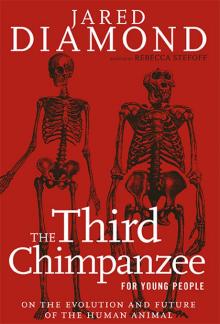 The Third Chimpanzee: The Evolution and Future of the Human Animal
The Third Chimpanzee: The Evolution and Future of the Human Animal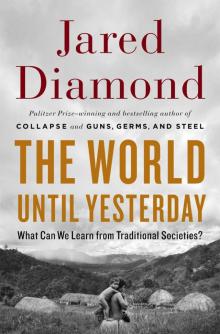 The World Until Yesterday: What Can We Learn From Traditional Societies?
The World Until Yesterday: What Can We Learn From Traditional Societies?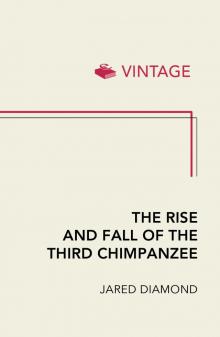 The Rise and Fall of the Third Chimpanzee
The Rise and Fall of the Third Chimpanzee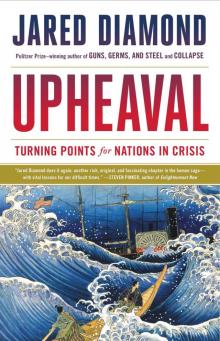 Upheaval: Turning Points for Nations in Crisis
Upheaval: Turning Points for Nations in Crisis Guns, Germs, and Steel
Guns, Germs, and Steel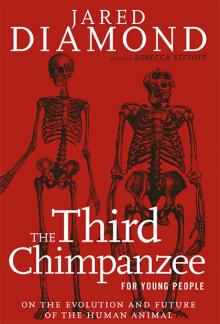 The Third Chimpanzee for Young People
The Third Chimpanzee for Young People Why Is Sex Fun?
Why Is Sex Fun?